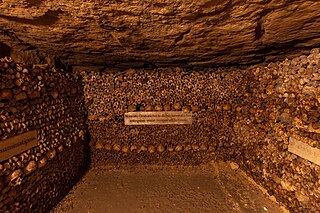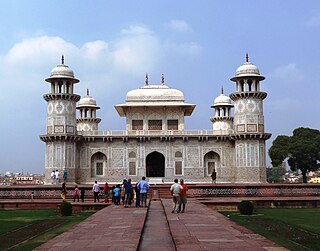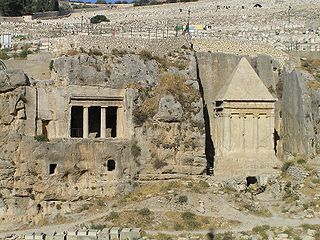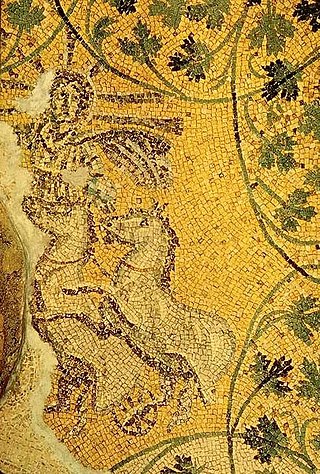
Catacombs are man-made underground passages primarily used for religious purposes, particularly for burial. Any chamber used as a burial place is considered a catacomb, although the word is most commonly associated with the Roman Empire. [1] [2]

Catacombs are man-made underground passages primarily used for religious purposes, particularly for burial. Any chamber used as a burial place is considered a catacomb, although the word is most commonly associated with the Roman Empire. [1] [2]
The first place to be referred to as catacombs was the system of underground tombs between the 2nd and 3rd milestones of the Appian Way in Rome, where the bodies of the apostles Peter and Paul, among others, were said to have been buried. The name of that place in Late Latin was L.L. fem. nom. pl. n. catacumbas (sing. catacumba) a word of obscure origin, possibly deriving from a proper name or a derivation of the Greek phrase cata cumbas, "near the quarries". The word referred originally only to the Roman catacombs, but was extended by 1836 to refer to any subterranean receptacle of the dead, as in the 18th-century Paris catacombs. [3] The ancient Christians carved the first catacombs from soft tufa rock. (ref)" (World Book Encyclopedia, page 296)
All Roman catacombs were located outside city walls since it was illegal to bury a dead body within the city, [4] providing "a place…where martyrs' tombs could be openly marked" and commemorative services and feasts held safely on sacred days. [5]




Catacombs around the world include:
There are also catacomb-like burial chambers in Anatolia, Turkey; in Sousse, Tunisia; in Syracuse, Italy; Trier, Germany; Kyiv, Ukraine. Capuchin catacombs of Palermo, Sicily, were used as late as the 1920s. Catacombs were available in some of the grander English cemeteries founded in the 19th century, such as Sheffield General Cemetery (above ground) and West Norwood Cemetery (below ground). There are catacombs in Bulgaria near Aladzha Monastery [9] and in Romania as medieval underground galleries in Bucharest. [10] In Ukraine and Russia, catacomb (used in the local languages' plural katakomby) also refers to the network of abandoned caves and tunnels earlier used to mine stone, especially limestone.
In Italy, possible Catacombs are also located in Alezio, beside the Sanctuary of Santa Maria dell'Assunta, as well as the basement of Santa Maria della Lizza Sanctuary .[ clarification needed ]
Catacombs, although most notable as underground passageways and cemeteries, also house many decorations. There are thousands of decorations in the centuries-old catacombs of Rome, catacombs of Paris, and other known, some of which include inscriptions, paintings, statues, ornaments, and other items placed in the graves over the years.
Most of these decorations were used to identify, immortalize and show respect to the dead. Decorations in the catacombs of Rome were primarily decorated with images and words exalting Christ or depicting scenes from the Old and New Testaments of the Bible. [11] Much of the sculpture work and art, other than engravings on the walls or tombs, has been preserved in places such as the Museum of Saint John Lateran, Christian Museum of Berlin University, and the Vatican. [12]
Three representations of Christ as Orpheus charming animals with peaceful music have been found in the catacombs of Domatilla and St. Callista. [13] Another figure was made of gilded glass and dates back to the fourth century, featuring Jesus with the world balanced in his hand and a scroll at his feet. [14]
Although thousands of inscriptions were lost as time passed, many of those remaining indicate the social rank or job title of its inhabitants; however, most of the inscriptions simply indicate how loving a couple was, or the love of parents and such. A common and particularly interesting one found in Roman catacombs is the Ichthys, or "Monogram of Christ" which reads ΙΧΘΥΣ, standing for "Jesus Christ, Son of God, Savior". [13]
In recent years unique strains of bacteria have been discovered that thrive in catacombs, inducing mineral efflorescence and decay. These include Kribbella sancticallisti , Kribbella catacumbae , and three types of non-thermophilic (low-temperature) Rubrobacter . [15] [16]
(Latin: catacumbas - district near ancient Rome where one of the earliest Christian cemeteries was located). Subterranean rock-cut burial complex.

The Catacombs of Paris are underground ossuaries in Paris, France, which hold the remains of more than six million people. Built to consolidate Paris's ancient stone quarries, they extend south from the Barrière d'Enfer former city gate; the ossuary was created as part of the effort to eliminate the effects of the city's overflowing cemeteries. Preparation work began shortly after a 1774 series of basement wall collapses around the Holy Innocents' Cemetery added a sense of urgency to the cemetery-eliminating measure, and from 1786, nightly processions of covered wagons transferred remains from most of Paris's cemeteries to a mine shaft opened near the Rue de la Tombe-Issoire.

A tomb or sepulcher is a repository for the remains of the dead. It is generally any structurally enclosed interment space or burial chamber, of varying sizes. Placing a corpse into a tomb can be called immurement, although this word mainly means entombing people alive, and is a method of final disposition, as an alternative to cremation or burial.

The use of rock-cut cave tombs in the region began in the early Canaanite period, from 3100–2900 BCE. The custom lapsed a millennium, however, before re-emerging in the earliest Israelite tombs, dating to the 9th century BCE in Jerusalem. The use of rock-cut tombs reached its peak in the 8th and 7th centuries BCE, before rapidly declining and eventually falling out of use in the 6th century BCE in some regions. It reappeared during the Second Temple period and continued into the Late Roman and Byzantine periods.

An ossuary is a chest, box, building, well, or site made to serve as the final resting place of human skeletal remains. They are frequently used where burial space is scarce. A body is first buried in a temporary grave, then after some years the skeletal remains are removed and placed in an ossuary. The greatly reduced space taken up by an ossuary means that it is possible to store the remains of many more people in a single tomb than possible in coffins. The practice is sometimes known as grave recycling.

The Catacombs of Rome are ancient catacombs, underground burial places in and around Rome, of which there are at least forty, some rediscovered only in recent decades.

A columbarium, also called a cinerarium, is a structure for the reverential and usually public storage of funerary urns holding cremated remains of the dead. The term comes from the Latin columba (dove) and originally solely referred to compartmentalized housing for doves and pigeons, also called dovecotes.

Saint Peter's tomb is a site under St. Peter's Basilica that includes several graves and a structure said by Vatican authorities to have been built to memorialize the location of Saint Peter's grave. St. Peter's tomb is alleged near the west end of a complex of mausoleums, the Vatican Necropolis, that date between about AD 130 and AD 300. The complex was partially torn down and filled with earth to provide a foundation for the building of the first St. Peter's Basilica during the reign of Constantine I in about AD 330. Though many bones have been found at the site of the 2nd-century shrine, as the result of two campaigns of archaeological excavation, Pope Pius XII stated in December 1950 that none could be confirmed to be Saint Peter's with absolute certainty. Following the discovery of bones that had been transferred from a second tomb under the monument, on June 26, 1968, Pope Paul VI said that the relics of Saint Peter had been identified in a manner considered convincing. Only circumstantial evidence was provided to support the claim.
Antonio Bosio was a Maltese scholar, the first systematic explorer of subterranean Rome, author of Roma Sotterranea and first urban spelunker.

Felicitas of Rome, also anglicized as Felicity, is a saint numbered among the Christian martyrs. Apart from her name, the only thing known for certain about this martyr is that she was buried in the Cemetery of Maximus, on the Via Salaria on a 23 November. However, a legend presents her as the mother of the seven martyrs whose feast is celebrated on 10 July. The Eastern Orthodox Church celebrates their martyrdom on 25 January.

Beit She'arim necropolis is an extensive necropolis of rock-cut tombs near the remains of the ancient Jewish town of Beit She'arim. In early modern times the site was the Arab village of Sheikh Bureik; it was depopulated in the 1920s as a result of the Sursock Purchases, and identified as Beit She'arim in 1936 by historical geographer Samuel Klein.

A necropolis is a large, designed cemetery with elaborate tomb monuments. The name stems from the Ancient Greek νεκρόπολις nekropolis.

The Vatican Necropolis lies under the Vatican City, at depths varying between 5–12 metres below Saint Peter's Basilica. The Vatican sponsored archaeological excavations under Saint Peter's in the years 1940–1949 which revealed parts of a necropolis dating to Imperial times. The work was undertaken at the request of Pope Pius XI who wished to be buried as close as possible to Peter the Apostle. It is also home to the Tomb of the Julii, which has been dated to the third or fourth century. The necropolis was not originally one of the Catacombs of Rome, but an open-air cemetery with tombs and mausolea.

St. Paul's Catacombs are some of the most prominent features of Malta's early Christianity archeology. The archeological clearing of the site has revealed an extensive system of underground galleries and tombs dating from the third to the eighth centuries CE.

The Vigna Randanini are Jewish Catacombs between the second and third miles of the Appian Way close to the Christian catacombs of Saint Sebastian, with which they were originally confused. The catacombs date between the 2nd and 5th-centuries CE, and take their name from the owners of the land when they were first formally discovered and from the fact that the land was used as a vineyard (vigna). While Vigna Randanini are just one of the two Jewish catacombs in Rome open to the public, they can only be visited by appointment. They are situated below a restaurant and a private villa and entrance is from the Via Appia Pignatelli side. These catacombs were discovered by accident in 1859, although there is evidence that they had been pillaged before then. They cover an area of 18,000 square metres and the tunnels are around 700 metres long, of which around 400 can be seen.

There are hundreds of catacombs in Malta, principally found in Mdina, the former capital of the island. The catacombs are very small, but are in good preservation.

The Catacombs of Saint Gaudiosus are underground paleo-Christian burial sites, located in the northern area of the city of Naples.

The Catacombs of San Sebastiano are a hypogeum cemetery in Rome, Italy, rising along Via Appia Antica, in the Ardeatino Quarter. It is one of the very few Christian burial places that has always been accessible. The first of the former four floors is now almost completely destroyed.

The funerary art of ancient Rome changed throughout the course of the Roman Republic and the Empire and took many different forms. There were two main burial practices used by the Romans throughout history, one being cremation, another inhumation. The vessels used for these practices include sarcophagi, ash chests, urns, and altars. In addition to these, mausoleums, stele, and other monuments were also used to commemorate the dead. The method by which Romans were memorialized was determined by social class, religion, and other factors. While monuments to the dead were constructed within Roman cities, the remains themselves were interred outside the cities.

The Catacomb of Saint Thecla is a Christian catacomb in the city of Rome, near the Via Ostiense and the Basilica of Saint Paul Outside the Walls, in the southern quarter of the ancient city. The catacomb was constructed in the fourth century of the Common Era, linked with a basilica to the saint that is alluded to in literature. Because of the enigmatic endings of the legends of Saint Thecla of Iconium, it is still unknown whether the tomb belongs to the saint or if it belongs to a different noblewoman. Regardless, the tomb is an example of early Christian funerary practice and artwork. The most recent discovery in the catacomb was the depiction of several apostles, hypothesized to be their earliest portrayals. Of particular interest to many is the portrait of the Apostle Paul.

The Catacombs of Domitilla are an underground Christian cemetery named after the Domitilla family that had initially ordered them to be dug. Located in Rome, Italy, are the human-made subterranean passageways used for cemeteries and religious practice. They are among the largest catacombs in Rome, spreading out 17 km, largely along the ancient Via Ardeatine, laid out on four levels, and housing approximately 15,000 bodies underground. The Catacombs of Domitilla are the only catacombs in Rome that have an underground Basilica and are of one only five Roman catacombs open to the public. Constructed during the second and third centuries, this labyrinth of underground passages contains frescoes and a wealth of Christian iconography while also presenting masterful engineering skills and innovative architectural techniques.